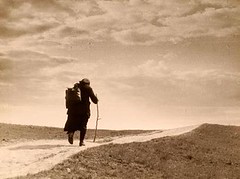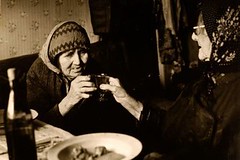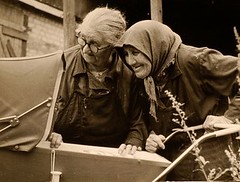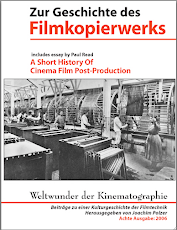 Film-Nr.: 542
Film-Nr.: 542Vorführungstermin: Sonntag, 16. August 2009, 16 Uhr (Zweiter Film) [VN54]
Themenschwerpunkt: Unglaubliche Geschichten aus Russland (1) | Filme über Fotografen (2) | Würdigungen (3)
Englischer Titel: The Photographer
Originaltitel: Fotograf
Deutscher Titel: Der Fotograf
Herkunft: Kanada 2008
Laufzeit: 60 min
Sprachfassung: Russische Originalfassung mit englischen Untertiteln
Regie: Thomas Lahusen, Alexander Gershtein, Tracy McDonald
Produzent: Thomas Lahusen, Sergei Kapterev,
Schnitt: Thomas Lahusen
Kamera: Alexander Gershtein
Musik:
Produktion: Chemodan Films, Toronto
URL Film-Homepage: http://www.chemodanfilms.com
Premierenstatus: Europäische Erstaufführung
Bisherige Aufführungen:
Kurzinhalt: Er wurde der "Cartier-Bresson der russischen Provinz" genannt: Evgeny Kashirin (1949 - 2007) war der Chronist einer visuellen, sozialen und kulturellen Geschichte seiner Zeit und seiner Orte, der inzwischen drei Generationen junger Leute dahin gehend inspiriert hat, wie man Schönheit und Bedeutung in seiner Umwelt erkennen kann.
Trailervideo: http://blip.tv/file/2253003 + http://www.youtube.com/watch?v=9Y_CYSqGMh4
Englische Synopsis: A film about Riazan photographer Evgeny Kashirin (1949 - 2007), who recorded a poignant visual, social, and cultural history of his time and place, and who inspired three generations of young people to see meaning and beauty in the world around them.
 >
> >
>
Englische Werkbeschreibung: The Photographer is Evgeny Kashirin (1949 - 2007). From the age of 19, Kashirin captured his time and place, the central Russian province of Riazan, through the lens of his black and white camera. Our film tells (t)his story through the words of his students and acquaintances, his photographs, and footage of the photographer’s own projected film compilations accompanied by his haunting blank verse. Together they take the form of a triptych: a dying rural life, a train, and the story of a man who traded his wife for a marble statue of Judith. In the film’s prelude, Kashirin visits the remains of the church and the cemetery of his childhood home in the village of Zatishe on a cold autumn afternoon. Zatishe is difficult to translate into English, the closest approximation is “Lull.” Despite the grey day Kashirin is alive and energetic as he lopes through the high grass. A young man speaks of the ways in which Kashirin opened up a world for him in a dark room in a dreary Soviet city. A city and a world that Kashirin helped him see in a new way. The photographer shepherded three generations of young people in a dilapidated centre for youth technical arts in downtown Riazan. He defended this coveted space in a city and a country where space was always at a premium. Kashirin’s photographs blatantly contradict the views of some “specialists,” according to whom Kashirin was not a “true historian”. But his massive archive of photographs is a vivid and poignant visual social and cultural history of his times. It is a history that is alive in its very rawness and beauty. The first panel of the triptych is “Lull.”
 >
> >
>
It is the story of Kashirin’s “grandmothers,” Klava and Frosia, one an abandoned orphan and the other the wife of a priest, both on the margins of official Soviet society. They lived, worked, and survived together for fifty years. Eternal, peasant Russia? Yet when the two old women reluctantly accept a television, pressed on them by their grandson, it is the May Day parade they like best. The second panel is “Movement.” People on a slow train that crawls from town to town passing the villages of Riazan along the way. Again, life is unfolding, captured in stills showing a Russia that not many foreigners ever see, while the haunting voice of the photographer closes upon the last image: “And again children, again a dream, again movement, glances…” The third part of the Triptych is “The Stone Woman.” A man travels to Leningrad to buy furniture, and comes back with a marble woman. In disgust his wife leaves him but she is easily replaced as he paints for his sculpture, he buys her companions, and celebrates her birthday on the 8th of March. “The Stone Woman” is the photographer’s own journey, “away from the light of the banal Riazan streets” because “everyone wants to live in beauty.” The Epilogue revisits the same ruined church of Zatishe, the graves of Klava and Frosia, now overgrown with weeds. The scenes were shot a few days after Kashirin’s death. The black and white photographs have been replaced by the intense and almost suffocating colors of summer. The score for The Photographer was composed by the virtuoso of the Russian seven-string guitar Oleg Timofeyev and interperted by the Timofeyev Ensemble. Shooting started in the fall of 2005. A second round of filming took place in June and July 2007. Evgeny Kashirin died on June 29, 2007. We were able to say goodbye to him.
Das Globians Doc Fest zeigte bereits zwei frühere Produktionen der kanadischen Chemodan Films, nämlich "Komsomolsk mon amour" (2008) über alternatives Theater in Komsomolsk (Amur) sowie "The Province of Lost Films" (2006) zu den Überbleibseln der Cinefizierung unter Stalin; Chemodan Films in Toronto besteht aus dem Filmemachertrio um Thomas Lahusen, Alexander Gershtein und Tracy McDonald.
Dieser Film aus dem Programm des Globians Doc Fest wird wiederholt und zwar am 09. Dezember 2009 um 18.00 Uhr im Eiffelturm-Kino Berlin (im Centre Français de Berlin), Müllerstr. 74, U-Bahnhof Rehberge/Afrikanische Straße.
GLOBIANS DOC FEST BERLIN
August 12 - 17, 2009
Kino Toni, Antonplatz












Keine Kommentare:
Kommentar veröffentlichen
Hinweis: Nur ein Mitglied dieses Blogs kann Kommentare posten.